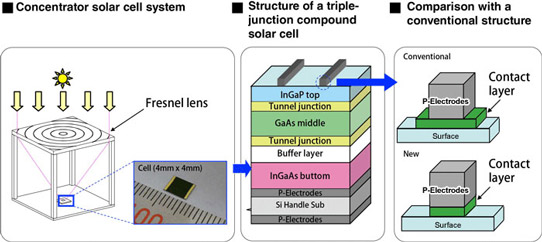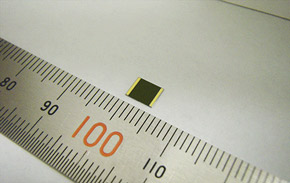Japan's Sharp Corp has used a concentrator triple-junction III-V compound semiconductor photovoltaic cell to achieve a solar energy conversion efficiency of 44.4%, exceeding the record of 43.5% for concentrating conversion efficiency set in March 2011 by Solar Junction of San Jose, CA, USA, a manufacturer of III-V multi-junction solar cells for concentrated photovoltaics (CPV), and equalled by Sharp in June 2012.
Measurement of the 44.4% conversion efficiency was confirmed in April by the Fraunhofer Institute for Solar Energy Systems (ISE) in Freiburg, Germany cell surface of about 0.165cm2 under a light-concentrating magnification of 302 times. One of several organizations around the world that officially certifies efficiency measurements in solar cells, ISE is one of the participating members from the European Union in the the collaboration 'NGCPV: A new generation of concentrator photovoltaic cells, modules and systems', which began in June 2011 as part of the project 'R&D in Innovative Solar Cells'.

Picture: Concentrator triple-junction compound semiconductor solar cell with record conversion efficiency of 44.4%.
The latest record arose through work as part of the 'R&D on Innovative Solar Cells' project, promoted by Japan's New Energy and Industrial Technology Development Organization (NEDO), which is one of the country's largest public management organizations for promoting R&D as well as for disseminating industrial, energy, and environmental technologies.

By using photo-absorption layers made from compounds of multiple elements such as indium and gallium, compound semiconductor solar cells typically offer high conversion efficiency. Sharp's concentrator triple-junction compound solar cells use a proprietary technology that enables the efficient conversion of sunlight into electricity by means of a stack of three photo-absorption layers, the bottom-most of which is made from indium gallium arsenide (InGaAs).
Sharp says that, to achieve a concentrating conversion efficiency of 44.4%, it worked to widen the effective concentrator cell surface and ensure uniform width of the interface between the cell and the electrodes.
Because of their high conversion efficiency, compound solar cells have so far been used primarily on space satellites. However, Sharp's aim for the future is to apply this latest development in CPV power systems and make the use of compound solar cells more feasible in terrestrial applications.?





